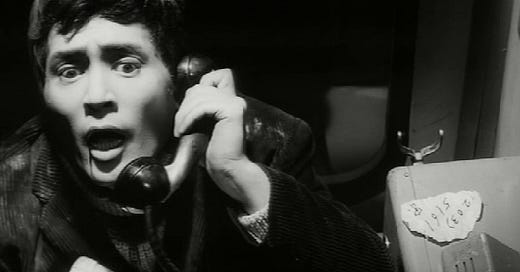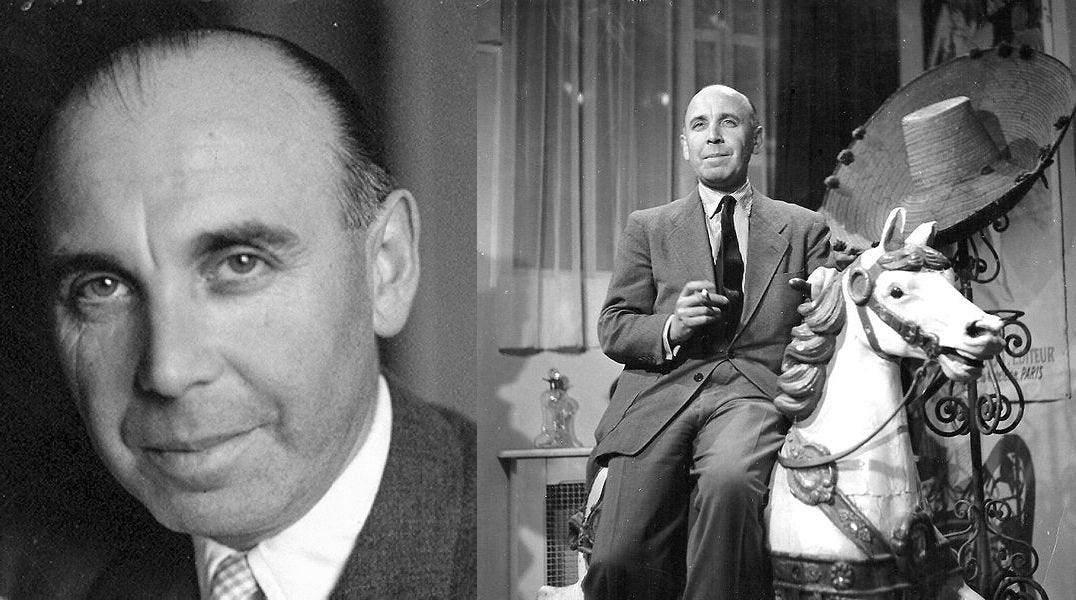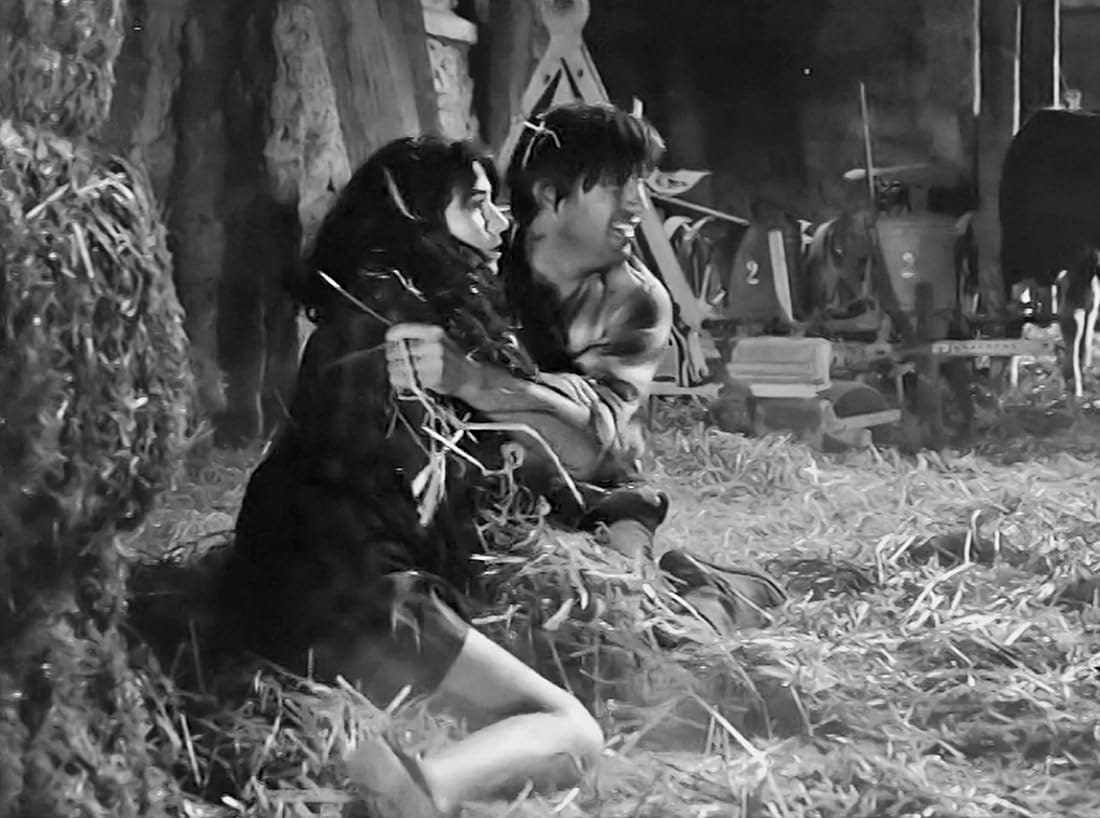THE keywords that will be taken away from our A RARE NOIR IS GOOD TO FIND 3 series (continuing at the Roxie Theater on Saturday/Sunday August 19/20) are almost certain to be: “incredible variety.” This was evident as the first four films (AVENTURERA, DEATH WHISTLES THE BLUES, EYES LEAVE TRACES & PASSPORT FOR A CORPSE) played out last Sunday; and my hunch is that this will only intensify as we continue another world-spanning odyssey of forgotten/lost foreign film noir.
There are still a very few single tickets available for the upcoming shows ($16 for double features, $18 for the Sunday matinee triple feature), so should the following prove intriguing, please move fast to secure your admission…
WE begin with a bit of “forgotten auteur” advocacy that’s unavoidable in the curious case of Emil-Edwin Reinert, a director of prodigious talent whose career was slow to develop due to the vagaries of World War II. Even after he obtained consistent work after the war, Reinert was mostly wasted in comedies whose scripts leave little room for him to display his meticulously perverse originality.
ADVENTURES IN VIENNA is his last film (he died at age 50 the year after its release) and it is a superb, assured follow-up to his singular French noir QUAI DE GRENELLE (1950), one of the highlights of our 2018 FRENCH HAD A NAME FOR IT festival (#5), which focused on French noir in the 1950s. (The star-crossed Henri Vidal had a role in it that operated as a kind of “career metaphor”: if you missed it then, fear not—we plan to reprise it in 2024.)
Reinert and his cinematographer Helmuth Ashley (whose affinity for noir lighting will be immediately apparent) pull out all the stops as they update the 1935 proto-noir ICH WAR JACK MORTIMER into an intricate showcase for treachery and deception, which all plays out on the night of New Year's Eve. Gustav Frolich, Francis (Franz) Lederer and a young Cornell Borchers are all highly effective in their roles.

It’s followed by another intriguing remake: SATAN TEMPTS WITH LOVE (1960), which adds a steamy component to the beloved triangle noir VOYAGE SANS ESPOIR (1943)—one of a handful of French noirs we’ve reprised—due to the presence of the doomed, uber-shapely British bombshell Belinda Lee.
WE then move to Greece to experience the unique intensity that manifests in noir-inflected filmmaking (most of which remains resolutely hidden away from audiences—and not just in America. Our two features—LOLA (1964) and O FOVOS/THE FEAR (1966)—could not be more different in their settings (urban criminal underworld vs. unsettling provincial underbelly), but they capture a kind of angst that is “unto itself” in terms of European filmmaking.
O FOVOS is particularly raw in its accelerating progression, with an urgency that is so palpable that audiences might not be surprised to discover that director Kostas Manoussakis was unable to make another film (this was his third and last feature).
SUNDAY (August 20th) brings five more films to keep the blood pumping, beginning with two from Norway featuring characters with what might best be terms “peregrinating flaws.” THE CHASERS (1959) brings us another highly uncompromising director in Erik Lochen, whose strategy is to keep the character interaction in a state of constant upheaval throughout. Few films with any level of “noir feel” break the fourth wall: THE CHASERS lives to break the fourth wall, while also putting cracks in the first, second and third as well. (It was not for no reason that we put this “side-by-side” with O FOVOS in the viewing progression, but separated them by eighteen hours!)
We experience a more conventional intensity in FIRE IN THE NIGHT (1955), where a downtrodden reporter enters into a series of fugue states as his career spirals into a series of bizarre “compensatory crimes”—you could call this “newspaper firebug noir” and not be wrong. (Director Arne Skouen will be familiar to MIDCENTURY MADNESS attendees due to his spooky LAKE OF THE DEAD (1958), which screened in that series last year.)
What is quite possibly our fiercest-ever “triple turn” of outright nasty characters concludes with THE BEAST SHALL DIE (1959), which features a harrowing performance from one of the giants of Japanese cinema: Tatsuya Nakadai. The character arc of his increasingly psychopathic student-turned-murdering terrorist is beyond astonishing. Jeff Stafford, former TCM stalwart and mastermind of the Cinema Sojourns blog, has a very useful overview of this remarkable film by the criminally overlooked director Eizo Suguwa.
AND that brings us to our finale, Sunday evening’s hallowed reprise of two consummately masterful foreign noirs, epitomizing the far-flung, world-wide reach that “dark film” achieved in the sixties before the plug was pulled on the indelible “black-and-white aesthetic” that provides these films with their extra dimension.
These two films, Japan’s CASH CALLS HELL (1966), also featuring Tatsuya Nakadai in a completely different role, and Brazil’s ASSAULT ON THE PAY TRAIN (1962), both deserve to be in the mainstream of classic achievements within the still-incomplete noir pantheon. It’s nothing less than a criminal act in its own right that they remain so obscure, when they epitomize the roiling collision of flawed, struggling humanity and the nightmarish layers of inhumanity that impedes the creation of a more just, less corrupt, egalitarian world.
Someday, hopefully not in the not-too-distant future, the story of film noir will at last be complete, and we’ll have it pictured in our minds as a continuing raised fist of defiance to a world that continues to resist the type of progress that makes all lives better. At that point, these two films—where one man wishes to escape his criminality but is sucked into something beyond his control, while the other valiantly attempts to overcome the anarchic collapse of noble but overly-grandiose criminal schemes—will have come to represent the apex of richness in the genre/style/movement/virus, in its sepulchral shadings, in its characters that tip their hands too soon and/or remain inscrutable even in their glassy-eyed death stare.
These two films embody all of this, and more. It may be that this double bill will be seen as the finest of all such excursions into the underworld. If you can grab a seat for these on Sunday night, you might glimpse the future, where we can see the crescendo that faded before our eyes as the “black-and-white world” was sold out, matter-of-factly marginalized, and sent to its own murky underworld. CASH CALLS HELL and ASSAULT ON THE PAY TRAIN, seen together, might even suggest to you that the power of such films was such that they somehow needed to be curtailed. How else to explain their continuing absence from movie screens?
BUT, then again, this could simply be the “renegade programmer” at (or near) the end of his (own) rope, donning sunglasses and adopting a (unintenionally) feral look that (unwittingly) unnerved the normally unflappable Mick LaSalle the other evening, giving off “assassin’s vibes.”
Do try to make a bee-line to the Roxie on Sunday, in order to determine what’s what. Am I a visionary…or am I simply off my nut?
One way or the other, I’ll be there—and, yes, I’ll have my shades on when it comes time to introduce these two films.








